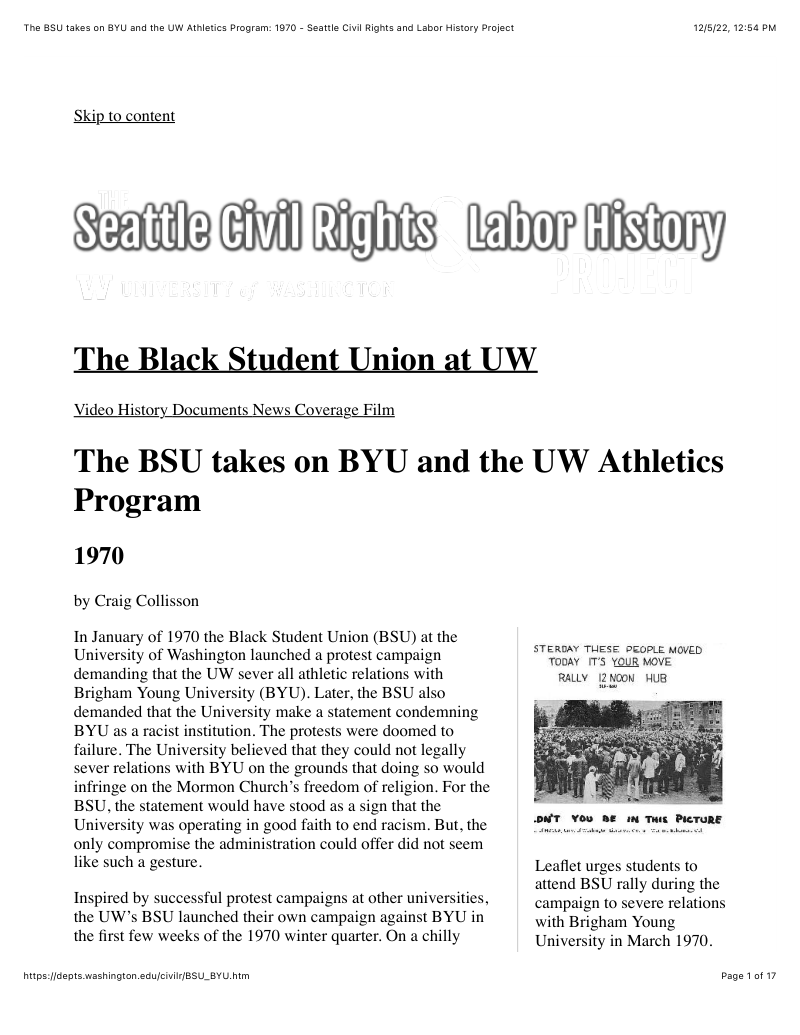Protests againts BYU's policies on Blacks carried out by University of Washington Black Student Union in March 1970.
- Type
- Website
- Source
- Craig Collisson
- Hearsay
- Journalism
- Reference
Craig Collisson, "The BSU takes on BYU and the UW Athletics Program," Seattle Civil Rights and Labor History Project, 2007, accessed December 5, 2022
- Scribe/Publisher
- University of Washington
- People
- Craig Collisson
- Audience
- General Public
- Transcription
The first large-scale protest occurred as promised at noon on Thursday, March 5. Almost 1,000 students met at the Husky Union Building (HUB) to hear speakers from the black community along with speakers from New Left organizations on campus. The Seattle Liberation Front, a radical New Left protest group, helped organize the rally and provided one of the speakers. After the speakers finished, the crowd marched across campus to the administration building where ten BSU representatives met with Hogness. Hogness reiterated that the University did not support racism in any form, but that he could not move up the decision date. The crowd then moved across campus and entered and occupied Thompson Hall, an academic building near the HUB. The tactic of occupying buildings was not new to student protests, and the BSU chose not to occupy the administration building because they believed the building to be protected by policemen in riot gear. The demonstrators quickly hung two banners from Thompson Hall—one read “Occupied,” the other “Marx Hall.” The demonstrators were planning on staying in the building until, according to Larry Gossett, “the University reevaluates its position on the BYU issue.”24 The prolonged occupation only lasted until 3:30 when the BSU decided to give the University one more day to make a decision.
The next day, again at noon, an even larger group of protesters met at the HUB. A heavy rain drove the protest indoors where more speeches were made. After the rally the BSU led students on a march around campus. This time the protesters used what the administration would later characterize as “hit and run” tactics. Protesters ran into buildings, entered classrooms and ordered the students there to leave. After occupying the building for ten minutes, the protesters would move on to another building. The administration called on the Seattle Police Department to end the demonstration, but BSU leaders, suspecting that the police had been called, decided to end the protest before the police could arrive. The Friday protest ended at the administration building where a BSU leader told the crowd, “We’re going to lay dead until noon Monday and then the shit is going to fly again.”25
Swiftly reacting to a second day of protests, Hogness obtained a temporary restraining order from the Superior Court of King County. The restraining order enjoined the Seattle Liberation Front, the BSU and “all others acting in concert” from “employing force or violence, or the threat of force or violence, against persons or property on plaintiff’s premises” along with four other edicts.26 In Monday’s _Daily,_ Hogness had the restraining order published as a letter to the University community and added that he “deeply regrets the necessity of this type of action. Thank you all for your cooperation.”27
The B. H. Roberts Foundation is not owned by, operated by, or affiliated with the Church of Jesus Christ of Latter-day Saints.

